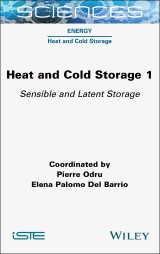Details

Heat and Cold Storage, Volume 1
Sensible and Latent StorageISTE Consignment 1. Aufl.
|
142,99 € |
|
| Verlag: | Wiley |
| Format: | |
| Veröffentl.: | 31.07.2024 |
| ISBN/EAN: | 9781394312504 |
| Sprache: | englisch |
| Anzahl Seiten: | 304 |
DRM-geschütztes eBook, Sie benötigen z.B. Adobe Digital Editions und eine Adobe ID zum Lesen.
Beschreibungen
<p><b><i>Heat and Cold Storage 1</i> is dedicated to sensible and latent heat storage processes.</b></p> <p>Beginning with some theoretical reminders, this book presents the main situations of low-temperature and high-temperature sensible storage for electricity generation. It also analyzes latent storage on phase-change materials (PCMs) from a fundamental standpoint, presenting the mechanisms to prepare PCMs and their integration into heat and cold storage processes. The most promising materials are presented, along with ways of improving the materials studied. Notions of technico-economic profitability are also defined.</p> <p>Finally, the book looks at heat storage in thermodynamic solar power plants and the wide variety of physical storage principles involved.</p>
<p>Foreword ix<br /><i>Philippe MARTY</i></p> <p><b>Chapter 1. Sensible Heat Storage: Overview 1</b><br /><i>Régis OLIVÈS</i></p> <p>1.1. Introduction 1</p> <p>1.2. General principles 2</p> <p>1.3. Storage configurations 2</p> <p>1.4. Modeling of thermocline storage 4</p> <p>1.5. References 11</p> <p><b>Chapter 2. Low-Temperature Sensible Heat Storage 13</b><br /><i>Pierre ODRU</i></p> <p>2.1. Sensible heat storage associated with buildings 13</p> <p>2.1.1. Short duration storage 14</p> <p>2.1.2. Long duration (seasonal) solar heat storage 16</p> <p>2.1.3. The stratification problem 16</p> <p>2.2. Underground thermal energy storage 17</p> <p>2.2.1. Principle of the aquifer thermal energy storage 19</p> <p>2.2.2. Borehole thermal energy storage 21</p> <p>2.2.3. Other types of underground storage 23</p> <p>2.3. References 23</p> <p><b>Chapter 3. High-Temperature Heat Storage for Electricity 25</b><br /><i>Lionel NADAU, Philippe MUGUERRA and Pierre ODRU</i></p> <p>3.1. Heat storage associated with compressed air electricity storage 28</p> <p>3.1.1. Adiabatic CAES 29</p> <p>3.1.2. Thermal energy storage 31</p> <p>3.1.3. Search project 31</p> <p>3.1.4. SACRE project 35</p> <p>3.2. Electricity storage by Carnot batteries 37</p> <p>3.2.1. Modified Brayton cycle: operating principle 37</p> <p>3.2.2. Modified Brayton cycle: energy balance 39</p> <p>3.2.3. Feasibility 41</p> <p>3.2.4. Potential characteristics of a thermal pumping system 43</p> <p>3.2.5. Brayton cycle variant 44</p> <p>3.2.6. Phase change cycle 45</p> <p>3.3. References 46</p> <p><b>Chapter 4. Latent Heat Storage: Fundamentals and Most Widely Used Phase Change Materials 49</b><br /><i>Ana LAZARO and Erwin FRANQUET</i></p> <p>4.1. Fundamentals of latent heat storage 49</p> <p>4.2. Phase change materials classification and criteria for selection 52</p> <p>4.3. Commonly used PCMs 58</p> <p>4.4. Tecno-economic evaluation 61</p> <p>4.5. Emerging alternative materials 63</p> <p>4.6. References 65</p> <p><b>Chapter 5. Engineering Phase Change Materials to Improve Their Properties and Broaden Applications 69</b><br /><i>Stefania DOPPIU and Elena PALOMO DEL BARRIO</i></p> <p>5.1. Introduction 69</p> <p>5.2. Micro-/nanoencapsulated PCMs 73</p> <p>5.2.1. Shell materials and encapsulation methods 74</p> <p>5.2.2. Micro-/nanoencapsulated PCMs 77</p> <p>5.2.3. Innovative designs for versatile applications 80</p> <p>5.3. Shape-stabilized PCMs 83</p> <p>5.3.1. Overview of porous supports and preparation methods 85</p> <p>5.3.2. Porous carbon-based SS-PCMs 88</p> <p>5.3.3. Porous oxide-based SS-PCMs 94</p> <p>5.3.4. Summary of porous supports and perspectives 99</p> <p>5.4. Conclusion 102</p> <p>5.5. References 103</p> <p><b>Chapter 6. Latent Heat Storage Systems: Concepts and Applications 109</b><br /><i>Marie DUQUESNE and Wahbi JOMAA</i></p> <p>6.1. Introduction 109</p> <p>6.2. Types of systems and main components 111</p> <p>6.2.1. LH-TESS classification 111</p> <p>6.2.2. Materials 112</p> <p>6.3. Cold storage 115</p> <p>6.3.1. "Ice-on-tube" cold storage systems 120</p> <p>6.3.2. Cold storage systems with encapsulated PCM 120</p> <p>6.3.3. Cold storage systems with ice slurry 121</p> <p>6.3.4. Cold storage systems with ice recovery 121</p> <p>6.4. Applications in the building sector 122</p> <p>6.4.1. Passive systems 122</p> <p>6.4.2. Active use of PCM in buildings 125</p> <p>6.5. Applications in industry 127</p> <p>6.6. Concentrated solar power plants 129</p> <p>6.7. Other domains 134</p> <p>6.8. Conclusion 135</p> <p>6.9. References 139</p> <p><b>Chapter 7. Use of Hydrates for Cold Storage and Distribution in Refrigeration and Air-Conditioning Applications 151</b><br /><i>Anthony DELAHAYE and Laurence FOURNAISON</i></p> <p>7.1. Introduction 151</p> <p>7.2. Hydrate definition and properties 153</p> <p>7.2.1. Definition of gas hydrates 153</p> <p>7.2.2. Clathrate hydrate structures 154</p> <p>7.2.3. Semiclathrate structures 156</p> <p>7.2.4. Hydration number 156</p> <p>7.2.5. Phase diagram of water-CO2 mixtures including CO2 hydrates 157</p> <p>7.3. Hydrate systems for cold storage and distribution 158</p> <p>7.3.1. Refrigerant gas hydrate applied to cold storage 159</p> <p>7.3.2. CO2 hydrates applied to cold storage and distribution 159</p> <p>7.3.3. Quaternary salt hydrates for cold storage and distribution 160</p> <p>7.3.4. Other hydrates applied to cold storage and distribution. 161</p> <p>7.3.5. Mixed gas-salt/THF hydrates for cold storage and distribution 162</p> <p>7.4. Criteria for use of hydrates in refrigeration 163</p> <p>7.4.1. Thermodynamic criterion 163</p> <p>7.4.2. Flow criterion 167</p> <p>7.4.3. Thermal criterion 171</p> <p>7.4.4. Kinetic criterion 173</p> <p>7.4.5. Energy and environment criterion 175</p> <p>7.5. Hydrate applications in refrigeration and air-conditioning 176</p> <p>7.5.1. Slurry generation methods 176</p> <p>7.5.2. Examples of hydrate-based refrigeration systems 177</p> <p>7.6. Conclusion 181</p> <p>7.7. References 182</p> <p><b>Chapter 8. Concentrated Solar Power Plants and Storage 201</b><br /><i>Régis OLIVÈS</i></p> <p>8.1. Introduction 201</p> <p>8.2. Concentrated solar power plants and storage 202</p> <p>8.2.1. General principles 202</p> <p>8.2.2. Objectives and strategy 205</p> <p>8.2.3. Global performances and efficiency 206</p> <p>8.3. Storage types 211</p> <p>8.3.1. Sensible heat storage 212</p> <p>8.3.2. Latent heat storage 215</p> <p>8.3.3. Thermochemical storage 219</p> <p>8.3.4. Materials and fluids 223</p> <p>8.3.5. Other components 234</p> <p>8.4. Analysis of systems 236</p> <p>8.4.1. Active systems 237</p> <p>8.4.2. Passive systems 247</p> <p>8.4.3. Technical-economic analysis 261</p> <p>8.4.4. Life cycle analysis, efficiency, concentration and eco-design 263</p> <p>8.5. References 266</p> <p>List of Authors 271</p> <p>Index 273</p> <p>Summary of Volume 2 279</p>
<p><b>Pierre Odru</b> is an engineer at the Ecole Centrale de Lyon, France, and has retired from IFPEN. He worked in research and development in deep-sea oil production, gas transport with IFPEN and energy storage for the French National Research Agency.</p> <p><b>Elena Palomo Del Barrio</b> is a professor at the University of Bordeaux, France, and Scientific Director of the Thermal Energy Storage Department at CIC energiGUNE in Spain. She is a world-renowned specialist in phase-change materials and has published over 100 articles in international journals.</p>














